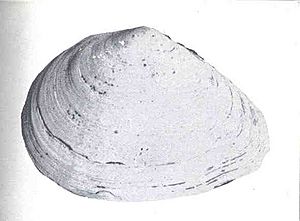Bent-nosed clam facts for kids
Quick facts for kids Bent-nosed clam |
|
|---|---|
 |
|
| Scientific classification | |
| Genus: |
Macoma
|
| Species: |
nasuta
|
The Macoma nasuta, also known as the bent-nosed clam, is a type of bivalve. Bivalves are sea creatures with two shells, like clams and oysters. This clam lives along the Pacific Ocean coast of North America. It usually grows to about 6 centimeters (about 2.4 inches) long. You can often find it buried in sand, about 10 to 20 centimeters (4 to 8 inches) deep. This round clam does not have any rib-like patterns on its shell. Long ago, Native American groups, like the Chumash from central California, used these clams.
Contents
What's in a Name?
The Macoma nasuta is usually called the bent-nosed clam or bent-nose Macoma. Sometimes, people confuse it with other similar clams like Macoma tersa or Macoma kelseyi.
How to Spot a Bent-Nosed Clam
The bent-nosed clam has a special hinge area without side teeth. Its shell is much shorter than twice its height. The back parts of both shells bend clearly to the right. Its siphons, which are like tubes it uses to breathe and eat, are separate and have a bright orange color.
The outer layer of its shell, called the periostracum, is usually very noticeable. This layer often makes the shell look dirty brown and wrinkled, especially around the edges.
Key Features to Remember
- Its shells bend sharply to the right at the back.
- Its siphons are orange.
- The outer layer (periostracum) is very clear.
Where Bent-Nosed Clams Live
These clams are common in areas where the ocean meets the land (the intertidal zone) and in slightly deeper waters (up to 50 meters or about 164 feet). They prefer muddy or sandy-muddy places with calm water. They can dig deep, up to 40 centimeters (about 16 inches) into the sand.
The M. nasuta and another clam called M. secta live in the same areas. Both are very common types of Macoma clams on the west coast of North America.
How Bent-Nosed Clams Eat
Bent-nosed clams eat by sucking up the top millimeter of sediment (mud or sand) using their siphon. They can move their siphon in a boring or rotating way to find new food. They have also been seen eating their own waste, which helps them get more nutrients. Scientists believe their siphon tip takes in all kinds of tiny particles without choosing.
Sometimes, tiny worms called nematodes have been found in their stomachs. Also, a small bivalve called Transenella tantilla has been found living inside the clam's stomach. Scientists are still learning about these relationships.
The clam keeps its "out-siphon" (for expelling water) about 1 centimeter (0.4 inches) below the surface. It takes about 1 to 9 hours for the clam to digest food. Smaller particles and tiny algae called diatoms seem to stay in their stomachs longer than other things they eat.
How Bent-Nosed Clams Reproduce
M. nasuta clams have separate male and female individuals. They usually release their eggs and sperm into the water in early summer.
History with People
There is old information from archaeological sites that shows Native American groups, like the Chumash people of central California, used to eat these clams.
Who Eats Bent-Nosed Clams?
Many animals like to eat bent-nosed clams. These include:
- Shore birds
- Lewis' Moon Snail (Polinices lewisii)
- Starfish (like Pisaster spp.)
- Crabs (such as Cancer productus, Metacarcinus gracilis, and Metacarcinus magister)
Known Parasites
Some tiny creatures live on or inside the bent-nosed clam and can harm it:
- Graffilla pugetensi: This parasite lives near the clam's heart.
- Telolecithus pugetensi: This parasite uses the M. nasuta as a second temporary home during its life cycle.

